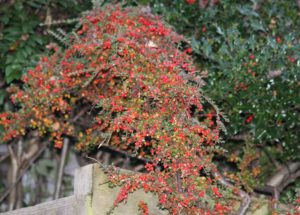
Winter here is a time of opening out, rather than closing in. When the leaves begin to fall, great gaps open in our horizons and we can see further out across the fields and towards the hills out eastward and the castle to the west. Evenings and mornings, skeins of geese fly over the house, west in the mornings towards Flanders Moss, southeast at night, down the river to Batterflats and Skinflats. The light is dimming by half-past three, and it is dark by five. There are fieldfares – one crashed into our bedroom window last week – and redwings, quarrelling with migrant blackbirds for the last of the rowan berries and I heard three robins singing against each other in the early twilight across the river, and long-tailed tits peeping to each other in the hedges. The fields have been ploughed, and some of them have already been sown. The deer sometimes come back to the riverbank now the building work has finished. There have been frosts, heavy rain, and some very strong winds.
Gardening is all but finished for the winter. Only the marigolds are still pushing out the last few rain-battered flowers, and the first winter jasmine has appeared.

I am about to package up the seeds I saved – marigolds, evening primrose, teasel, nigella, and the tiny seeds of nicandra physalodes (the shoo-fly plant), which are hidden in its exotic papery seedcase, which you can see here, stained with inky blue. I have put it in a vase with honesty teasel and nigella seedheads because it will keep that dramatic colour through the winter.

My attention has turned to indoor activities, cooking, learning to make sourdough bread, thinking about Christmas (already? I know!) and planning sewing projects for the dark nights, and new poetry and herbal blogposts for the new year. But there is still plenty of autumn colour,

and plenty of berries for the migrating birds. These are cotoneaster berries, which might even attract waxwings if the weather is cold enough. Far from shutting up shop, the territory of rain is opening its doors to winter.



